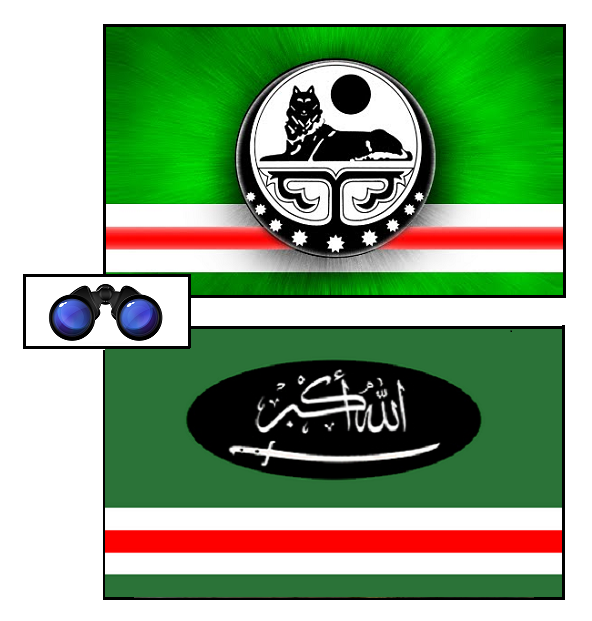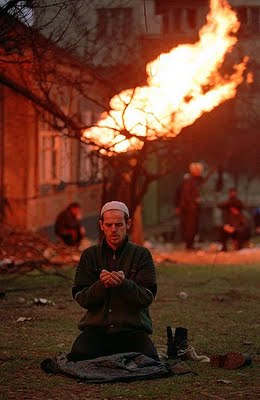Chechnya: of flags, prayers and swords, wolves, dogs, and hyenas
[ by Charles Cameron — powered by a 2009 post from Ibn Siqilli ]
**
As you know by now, I am fascinated by the oblique-angled windows on current affairs offered us by mythology, folklore, iconography… and for the record, I’ll specifically include flags under iconography.
Thus Amjad Jaimoukha‘s The Chechens: A Handbook (available here for Kindle at $135, a price every scholar can surely afford) caught my eye with the following quote:
The wolf (borz) is a potent national symbol, and its character traits are considered paragons to be emulated. Chechen men would be proud to be compared to wolves. ‘He was nursed by the She-Wolf,’ is a compliment implying adroitness and courage. Legend has it that it was the wolf that redeemed the world by standing heroically in face of the fury unleashed on doomsday. According to the Chechen ethos, the wolf is the only animal that would enter into an unequal match, making up for any disadvantage by its agility, wit, courage and tenacity. If it loses the battle, it lies down facing the foe in full acceptance of its fate — Chechen poise equivalent to the famed British ‘stiff upper lip’. This wolfish analogy is a depiction of how the Chechens have dealt with outside invaders for millennia.
According to mythology, god had created sheep for the wolf to enjoy, but man tricked it out of its ‘patrimony’, so it had to resort to ruse and robbery to reclaim its right.
That’s Chechen wolf-imagery in the upper flag, above.
**
Three things to note in those two paragraphs from Jaimoukha:
What calling a Chechen a “lone wolf” does to self-esteem:
Chechen men would be proud to be compared to wolves.
the deft touch of apocalypse:
Legend has it that it was the wolf that redeemed the world by standing heroically in face of the fury unleashed on doomsday.
and asymmetric warfare:
According to the Chechen ethos, the wolf is the only animal that would enter into an unequal match, making up for any disadvantage by its agility, wit, courage and tenacity.
**
As to prayers, the use of the takbir, “Allahu Akbar” above the swords in the lower flag is part of the muezzin’s call to prayer, and recited during the prayers themselves.
**
It was Ibn Siqilli‘s post, Portraits of Resistance & Jihad in Chechnya & the Islamic Emirate of the Caucasus with its three flags at the head of the post that set me off on this pilgrimage — and I’d also like to pay tribute to the sincerity of belief which gives rise to such a photo as this one, also taken from that post:
We’re back at prayer again…
**
On the topic of lone wolves — as I hope the quote above illustrates, word choices can have unintended impacts! Of note, Brian Michael Jenkins in Stray Dogs and Virtual Armies: Radicalization and Recruitment to Jihadist Terrorism in the United States Since 9/11 makes a distinction between stray dogs and lone wolves:
Analysts have tended to call such individuals “lone wolves,” in my view, a romanticizing term that suggests a cunning and deadly predator. A few of those recorded here display this kind of lethal determination, but others, while still dangerous, skulk about, sniffing at violence, vocally aggressive but skittish without backup. “Stray dogs,” not lone wolves, more accurately describes their behavior.
JM Berger talks about lone wolves in The Utility of Lone Wolves, or lack thereof:
If there were any doubts that lone wolves can be deadly, they were dispelled by Anders Breivik, the Norwegian anti-Muslim crusader who in July killed 69 young people in a coordinated attack using guns and a car bomb.
and again in The Boy Who Cried Lone Wolf:
Does it matter that some (but not all) of the terrorist network members described above were actually undercover law enforcement agents or informants? It doesn’t change the fact that none of these individuals was working alone. They were receiving advice, concrete assistance, and passive reinforcement from people they believed — rightly or wrongly — to be part of larger terrorist organizations.
None of this means that these guys aren’t dangerous, and none of this is to argue that they shouldn’t have been arrested. But they are not lone wolves. They are essentially al Qaeda volunteers …
But I’ll let Tim Furnish have the last word on nomenclature. In a comment here on Zenpundit he told us he’d originally entitled his HNN blog post “The Brothers Tsarnaev: Hyenas in the Service of the Mahdi” — and in the post itself he writes:
But viewing them from outside, analytically, as lone wolves may give them too much credit; while classifying them as stray dogs neutered of religious ideology gives the Islamic element too little. Perhaps a new paradigm, one of roaming hyenas, best describes the Tsarnaevs — characterized by anomie (fitting into neither domestic nor foreign contexts), the ability to feign surrender when necessary, and a propensity for attacking only the defenseless.
**
And oh, by way of cosmic irrelevance, my googling brought me here:
It’s a web-wild-world we live in!






April 27th, 2013 at 12:17 am
Another illuminating, exhilarating blog entry, Charles. Another touch of synchronicity: the U.S. government today released preliminary plans to withdraw special protection for wolves. Also, check out Oregon-7, a lone wolf that has wandered from Eastern Oregon down into California and appears to be heading back–all in quest of a mate, apparently. Can’t a wolf just have wanderlust? Also recommended (somehow it seems relevant to everything in the world) is the PBS Nature program on wolves and grizzly bears in Yellowstone National Park. They are so charming and familiar and exhilarating–at a distance.
A friend of mine who spent years in Africa, studying hyenas, was the first one to tell me that any smart predator will withdraw from its kill when the hyenas arrive–and that the female hyena (hello, Mama Tsarnaev?) has a penis.